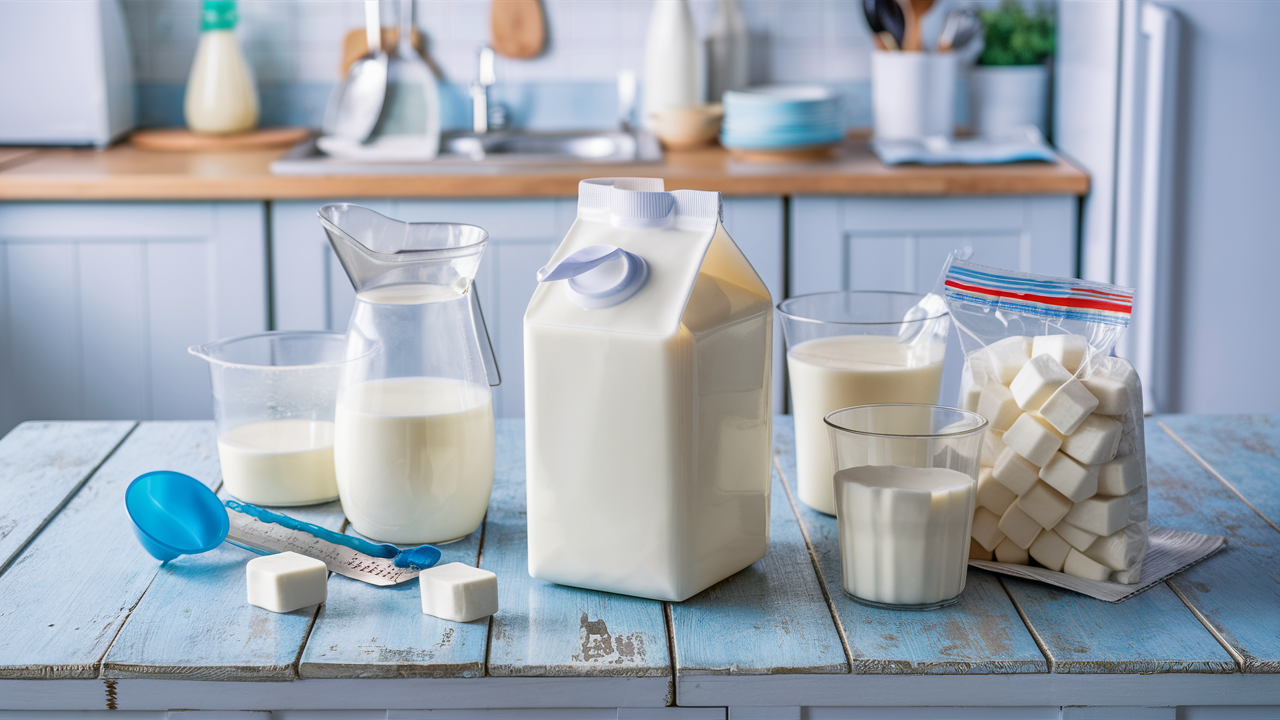Let’s face it—milk can be unpredictable. One day you’re racing through it with cereal bowls, lattes, and baking experiments; the next, you’re side-eyeing the carton wondering if it’ll go bad before you even finish half. Instead of stressing over the expiration date or guiltily pouring milk down the drain, why not freeze it? Yes, you read that right—you can freeze milk, and it’s easier than you might think.
Can Milk Really Be Frozen?
Absolutely, it can! Freezing milk is like giving it a little vacation—a chance to chill (literally) until you’re ready to use it again. However, it’s not without quirks. Milk expands as it freezes, and once thawed, it might separate a bit. This isn’t some dairy disaster; it’s just how milk behaves. A quick shake or stir usually brings it back to life.
That said, thawed milk is often better suited for cooking, baking, or blending into smoothies. If you’re a picky milk drinker, you might notice the texture isn’t exactly the same as fresh. But hey, it’s still perfectly good for your coffee or pancakes.
What Kind of Milk Can Be Frozen?
Not all milk is created equal, but most kinds can handle a stint in the freezer.
- Cow’s Milk: Whether it’s whole, 2%, or skim, dairy milk freezes well. Just remember, the higher the fat content, the more likely it is to separate.
- Plant-Based Milks: Almond, soy, oat, and coconut milk can all be frozen, though they may separate more noticeably. A quick blend after thawing helps smooth things out.
- Specialty Milks: Buttermilk, cream, and half-and-half can be frozen too, though they tend to separate. Use these for cooking rather than coffee.
The Step-by-Step Guide to Freezing Milk
Now, let’s get down to business. Freezing milk is as simple as it gets, but a little prep work ensures you won’t end up with a mess (or worse, cracked containers).
Step 1: Choose Your Container
If your milk is in a plastic jug, you’re already halfway there. Just pour out a cup or so to leave space for expansion. For milk in cardboard cartons, transfer it to a freezer-safe container—plastic or silicone works best. Avoid glass unless you enjoy cleaning up shattered milk popsicles.
Step 2: Portion It Out (Optional)
Got recipes in mind? Freeze milk in smaller amounts, like 1-cup portions, or use an ice cube tray for tiny, recipe-ready amounts. This saves you from thawing more than you need.
Step 3: Seal and Label
Make sure your container is airtight to prevent freezer burn. Label it with the date and, if you’re feeling fancy, the type of milk. Future you will thank you.
Step 4: Freeze It
Place your milk upright in the freezer. Make sure it’s not squished between a bag of peas and a frozen pizza—it needs a little breathing room.
Thawing Milk Without the Drama
When it’s time to bring your frozen milk back to life, patience is key. Thawing it too quickly can mess with the texture, so resist the urge to leave it on the counter.
Step 1: Thaw in the Fridge
Transfer your milk to the fridge and let it thaw slowly. Depending on the size of the container, this can take 12-24 hours. Planning ahead pays off here.
Step 2: Shake or Stir
Once thawed, you might notice the milk looks a little… weird. Don’t panic. Separation is normal. Give the container a good shake or stir, and it’ll be back to its creamy self.
Step 3: Use It Within 3-5 Days
Thawed milk doesn’t last as long as fresh milk, so try to use it within a few days. Whether you’re making soups, sauces, or your morning latte, thawed milk is versatile and ready to go.
Pro Tips for Freezing Milk
- Freeze in Portions: Ice cube trays are your secret weapon for small amounts. Each cube is roughly two tablespoons—perfect for coffee or recipes.
- Blend Plant-Based Milk: A quick blitz in the blender restores smoothness to almond or oat milk after thawing.
- Check for Freshness: Freezing doesn’t fix spoiled milk. Only freeze milk that’s fresh and smells fine.
Frequently Asked Questions
Can I refreeze milk?
Not recommended. Each freeze-thaw cycle alters the texture and increases the risk of bacterial growth.
How long can milk stay frozen?
For best quality, use frozen milk within 1-2 months. It’s safe for up to 6 months, but the flavor might start to fade.
What’s the best way to use thawed milk?
Cooking, baking, and blending are your best bets. Pancakes, creamy soups, and smoothies won’t notice a thing.
Why Freezing Milk is a Game-Changer
We’ve all been there—milk dangerously close to its expiration date and no plan to finish it in time. Freezing milk is like hitting the pause button, saving it for a rainy day (or pancake Sunday). It’s a simple hack that saves money, reduces waste, and ensures you’ve always got milk on hand when you need it.
So next time you’re staring down a ticking time bomb of dairy, take a deep breath, grab a container, and freeze it. You’ll thank yourself later when your morning coffee tastes just as good as ever.

